Strategic HRM Report: Dyson's Global Training and Challenges
VerifiedAdded on 2023/01/03
|8
|2564
|83
Report
AI Summary
This report provides an in-depth analysis of Dyson's strategic human resource management (HRM) practices in the context of its global expansion. It begins by defining strategic HRM and its importance, then focuses on the best practices, tools, and techniques Dyson employs to train its workers for international assignments. The report highlights the significance of cultural training, career-oriented development, and on-site training. It discusses Hofstede's cultural dimensions and their relevance to Dyson's HRM strategies. Furthermore, the report addresses the prominent challenges employees face when working abroad, such as language barriers and ineffective recruitment, and describes the human resource practices, like polycentric and geocentric approaches, that Dyson utilizes to overcome these difficulties. The report concludes by summarizing the key findings and emphasizing the importance of effective HRM for successful global operations.
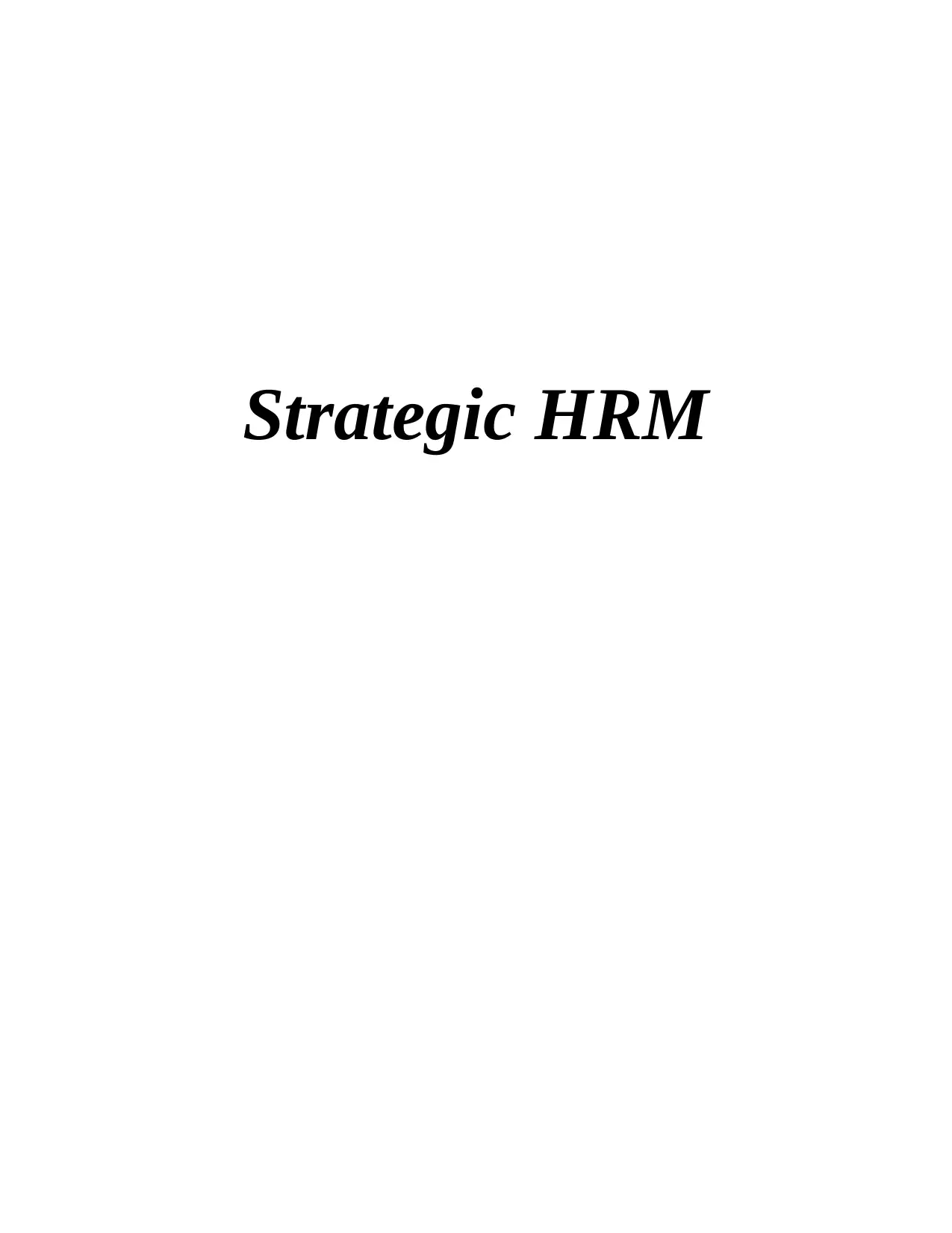
Strategic HRM
Paraphrase This Document
Need a fresh take? Get an instant paraphrase of this document with our AI Paraphraser
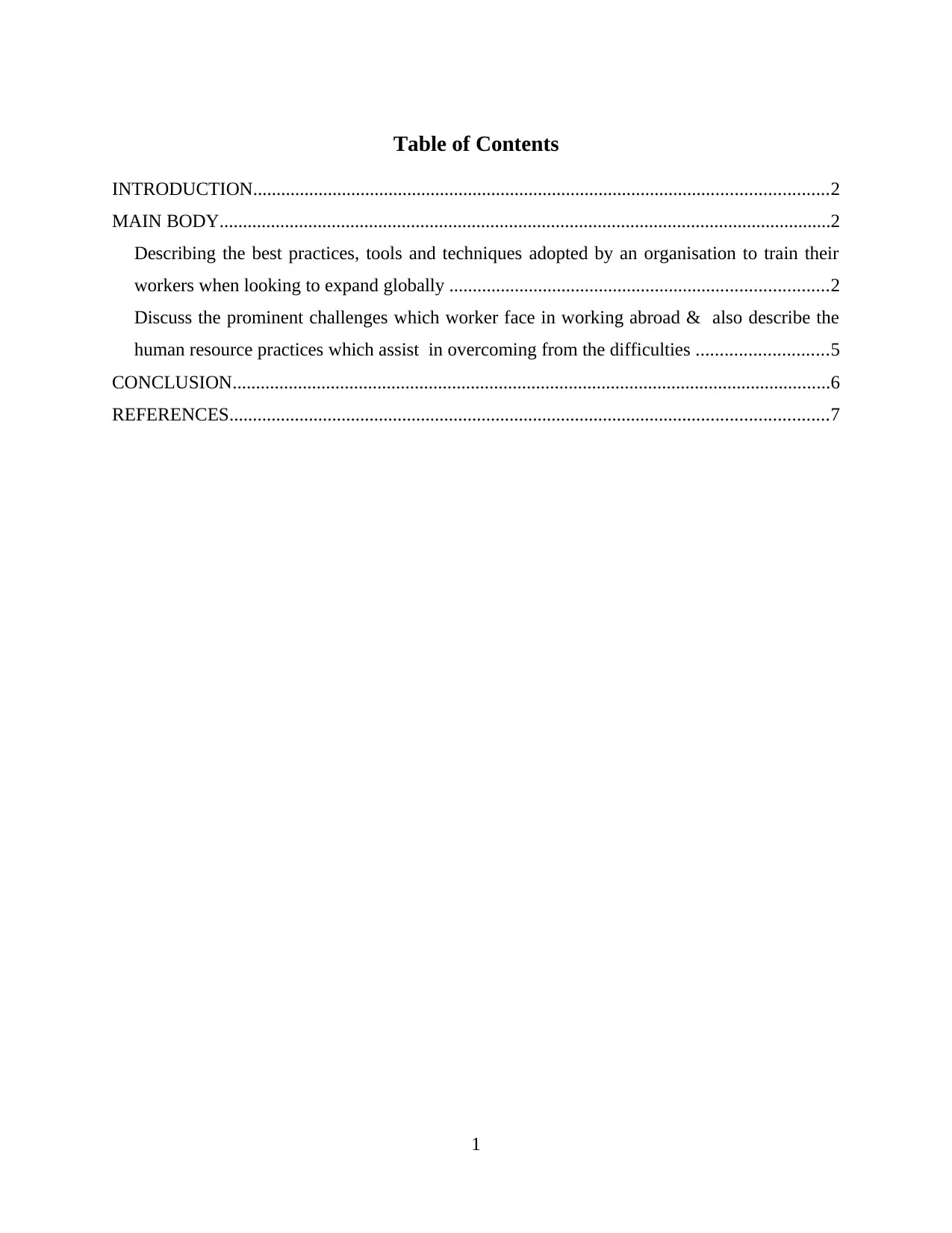
Table of Contents
INTRODUCTION...........................................................................................................................2
MAIN BODY...................................................................................................................................2
Describing the best practices, tools and techniques adopted by an organisation to train their
workers when looking to expand globally .................................................................................2
Discuss the prominent challenges which worker face in working abroad & also describe the
human resource practices which assist in overcoming from the difficulties ............................5
CONCLUSION................................................................................................................................6
REFERENCES................................................................................................................................7
1
INTRODUCTION...........................................................................................................................2
MAIN BODY...................................................................................................................................2
Describing the best practices, tools and techniques adopted by an organisation to train their
workers when looking to expand globally .................................................................................2
Discuss the prominent challenges which worker face in working abroad & also describe the
human resource practices which assist in overcoming from the difficulties ............................5
CONCLUSION................................................................................................................................6
REFERENCES................................................................................................................................7
1
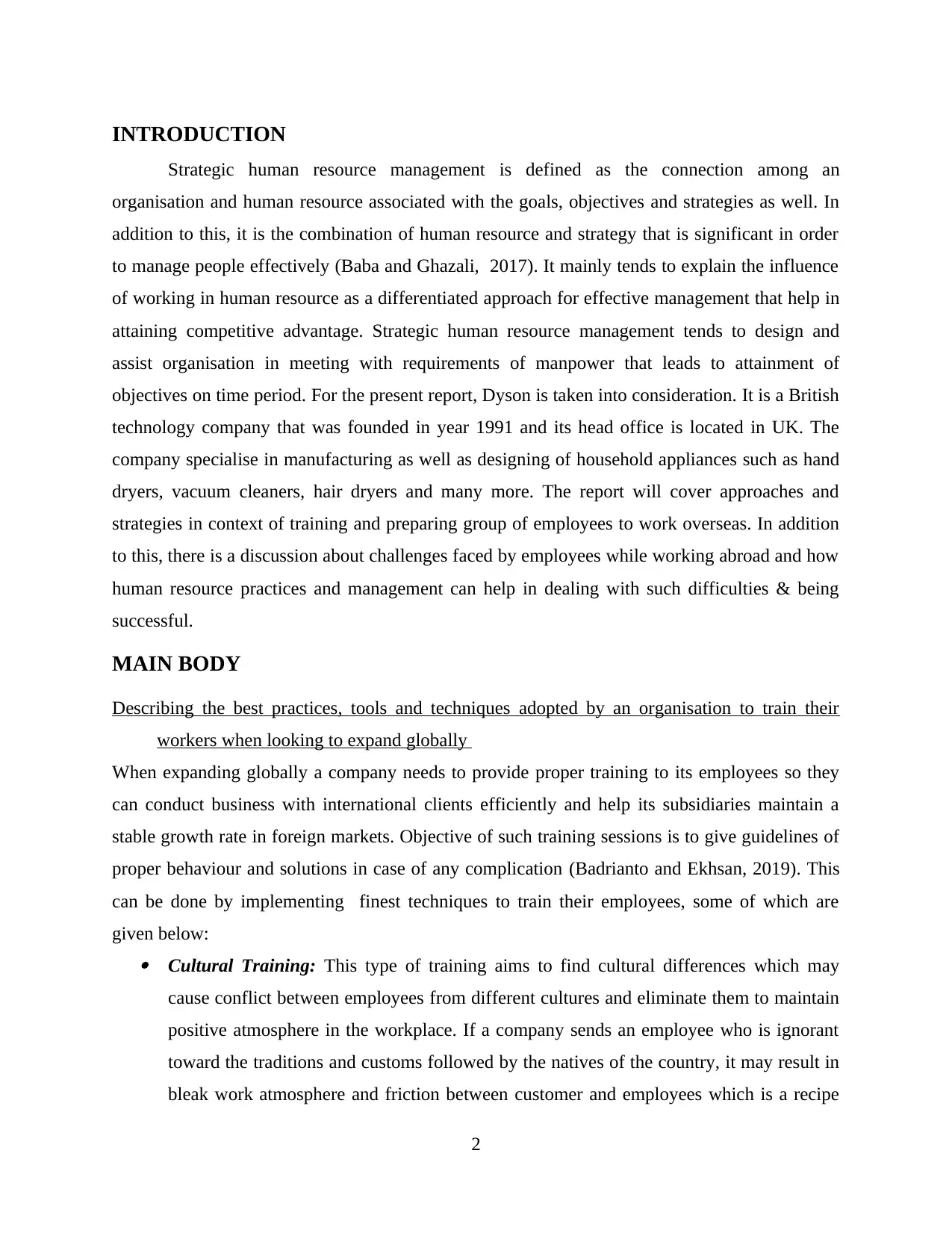
INTRODUCTION
Strategic human resource management is defined as the connection among an
organisation and human resource associated with the goals, objectives and strategies as well. In
addition to this, it is the combination of human resource and strategy that is significant in order
to manage people effectively (Baba and Ghazali, 2017). It mainly tends to explain the influence
of working in human resource as a differentiated approach for effective management that help in
attaining competitive advantage. Strategic human resource management tends to design and
assist organisation in meeting with requirements of manpower that leads to attainment of
objectives on time period. For the present report, Dyson is taken into consideration. It is a British
technology company that was founded in year 1991 and its head office is located in UK. The
company specialise in manufacturing as well as designing of household appliances such as hand
dryers, vacuum cleaners, hair dryers and many more. The report will cover approaches and
strategies in context of training and preparing group of employees to work overseas. In addition
to this, there is a discussion about challenges faced by employees while working abroad and how
human resource practices and management can help in dealing with such difficulties & being
successful.
MAIN BODY
Describing the best practices, tools and techniques adopted by an organisation to train their
workers when looking to expand globally
When expanding globally a company needs to provide proper training to its employees so they
can conduct business with international clients efficiently and help its subsidiaries maintain a
stable growth rate in foreign markets. Objective of such training sessions is to give guidelines of
proper behaviour and solutions in case of any complication (Badrianto and Ekhsan, 2019). This
can be done by implementing finest techniques to train their employees, some of which are
given below: Cultural Training: This type of training aims to find cultural differences which may
cause conflict between employees from different cultures and eliminate them to maintain
positive atmosphere in the workplace. If a company sends an employee who is ignorant
toward the traditions and customs followed by the natives of the country, it may result in
bleak work atmosphere and friction between customer and employees which is a recipe
2
Strategic human resource management is defined as the connection among an
organisation and human resource associated with the goals, objectives and strategies as well. In
addition to this, it is the combination of human resource and strategy that is significant in order
to manage people effectively (Baba and Ghazali, 2017). It mainly tends to explain the influence
of working in human resource as a differentiated approach for effective management that help in
attaining competitive advantage. Strategic human resource management tends to design and
assist organisation in meeting with requirements of manpower that leads to attainment of
objectives on time period. For the present report, Dyson is taken into consideration. It is a British
technology company that was founded in year 1991 and its head office is located in UK. The
company specialise in manufacturing as well as designing of household appliances such as hand
dryers, vacuum cleaners, hair dryers and many more. The report will cover approaches and
strategies in context of training and preparing group of employees to work overseas. In addition
to this, there is a discussion about challenges faced by employees while working abroad and how
human resource practices and management can help in dealing with such difficulties & being
successful.
MAIN BODY
Describing the best practices, tools and techniques adopted by an organisation to train their
workers when looking to expand globally
When expanding globally a company needs to provide proper training to its employees so they
can conduct business with international clients efficiently and help its subsidiaries maintain a
stable growth rate in foreign markets. Objective of such training sessions is to give guidelines of
proper behaviour and solutions in case of any complication (Badrianto and Ekhsan, 2019). This
can be done by implementing finest techniques to train their employees, some of which are
given below: Cultural Training: This type of training aims to find cultural differences which may
cause conflict between employees from different cultures and eliminate them to maintain
positive atmosphere in the workplace. If a company sends an employee who is ignorant
toward the traditions and customs followed by the natives of the country, it may result in
bleak work atmosphere and friction between customer and employees which is a recipe
2
⊘ This is a preview!⊘
Do you want full access?
Subscribe today to unlock all pages.

Trusted by 1+ million students worldwide
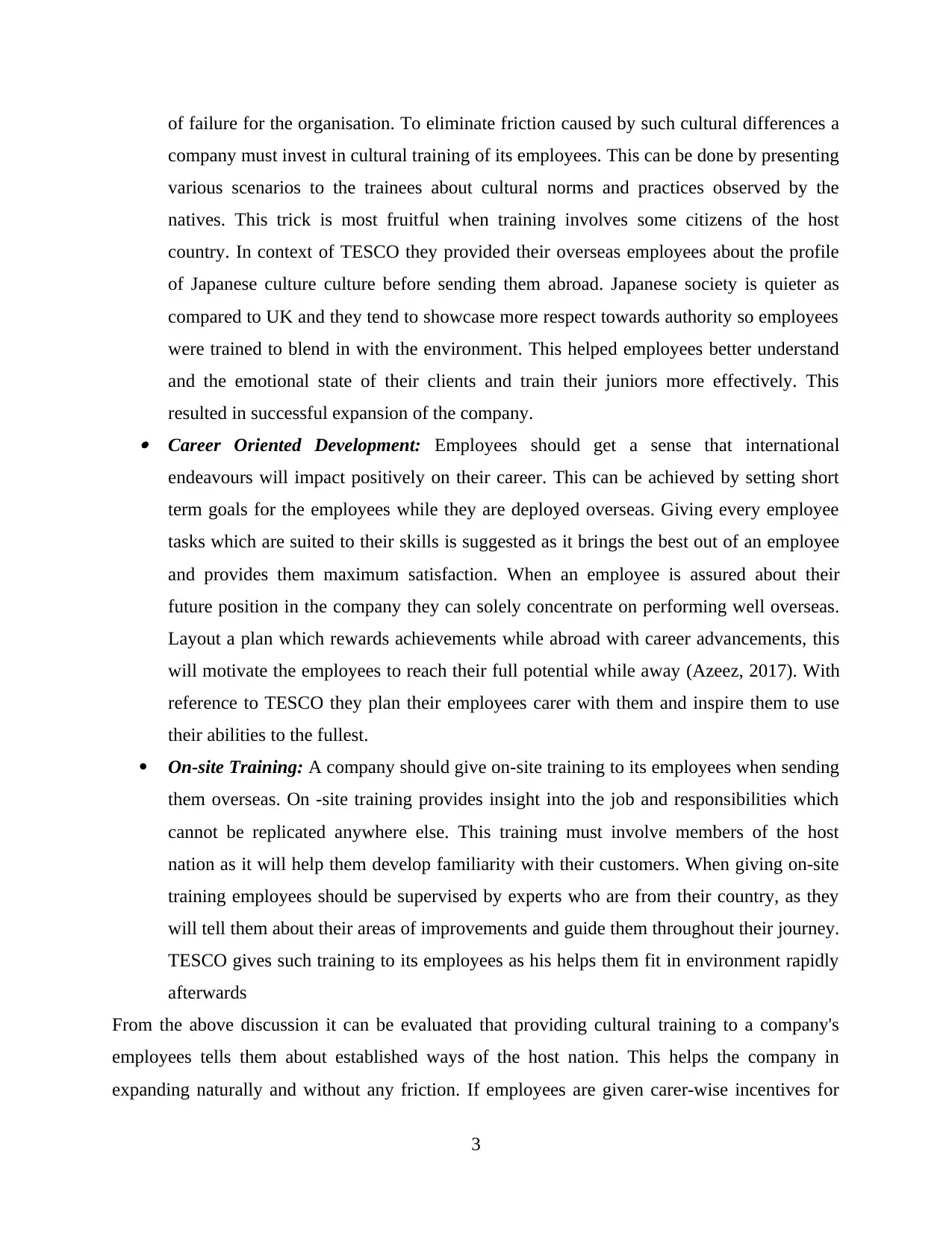
of failure for the organisation. To eliminate friction caused by such cultural differences a
company must invest in cultural training of its employees. This can be done by presenting
various scenarios to the trainees about cultural norms and practices observed by the
natives. This trick is most fruitful when training involves some citizens of the host
country. In context of TESCO they provided their overseas employees about the profile
of Japanese culture culture before sending them abroad. Japanese society is quieter as
compared to UK and they tend to showcase more respect towards authority so employees
were trained to blend in with the environment. This helped employees better understand
and the emotional state of their clients and train their juniors more effectively. This
resulted in successful expansion of the company. Career Oriented Development: Employees should get a sense that international
endeavours will impact positively on their career. This can be achieved by setting short
term goals for the employees while they are deployed overseas. Giving every employee
tasks which are suited to their skills is suggested as it brings the best out of an employee
and provides them maximum satisfaction. When an employee is assured about their
future position in the company they can solely concentrate on performing well overseas.
Layout a plan which rewards achievements while abroad with career advancements, this
will motivate the employees to reach their full potential while away (Azeez, 2017). With
reference to TESCO they plan their employees carer with them and inspire them to use
their abilities to the fullest.
On-site Training: A company should give on-site training to its employees when sending
them overseas. On -site training provides insight into the job and responsibilities which
cannot be replicated anywhere else. This training must involve members of the host
nation as it will help them develop familiarity with their customers. When giving on-site
training employees should be supervised by experts who are from their country, as they
will tell them about their areas of improvements and guide them throughout their journey.
TESCO gives such training to its employees as his helps them fit in environment rapidly
afterwards
From the above discussion it can be evaluated that providing cultural training to a company's
employees tells them about established ways of the host nation. This helps the company in
expanding naturally and without any friction. If employees are given carer-wise incentives for
3
company must invest in cultural training of its employees. This can be done by presenting
various scenarios to the trainees about cultural norms and practices observed by the
natives. This trick is most fruitful when training involves some citizens of the host
country. In context of TESCO they provided their overseas employees about the profile
of Japanese culture culture before sending them abroad. Japanese society is quieter as
compared to UK and they tend to showcase more respect towards authority so employees
were trained to blend in with the environment. This helped employees better understand
and the emotional state of their clients and train their juniors more effectively. This
resulted in successful expansion of the company. Career Oriented Development: Employees should get a sense that international
endeavours will impact positively on their career. This can be achieved by setting short
term goals for the employees while they are deployed overseas. Giving every employee
tasks which are suited to their skills is suggested as it brings the best out of an employee
and provides them maximum satisfaction. When an employee is assured about their
future position in the company they can solely concentrate on performing well overseas.
Layout a plan which rewards achievements while abroad with career advancements, this
will motivate the employees to reach their full potential while away (Azeez, 2017). With
reference to TESCO they plan their employees carer with them and inspire them to use
their abilities to the fullest.
On-site Training: A company should give on-site training to its employees when sending
them overseas. On -site training provides insight into the job and responsibilities which
cannot be replicated anywhere else. This training must involve members of the host
nation as it will help them develop familiarity with their customers. When giving on-site
training employees should be supervised by experts who are from their country, as they
will tell them about their areas of improvements and guide them throughout their journey.
TESCO gives such training to its employees as his helps them fit in environment rapidly
afterwards
From the above discussion it can be evaluated that providing cultural training to a company's
employees tells them about established ways of the host nation. This helps the company in
expanding naturally and without any friction. If employees are given carer-wise incentives for
3
Paraphrase This Document
Need a fresh take? Get an instant paraphrase of this document with our AI Paraphraser
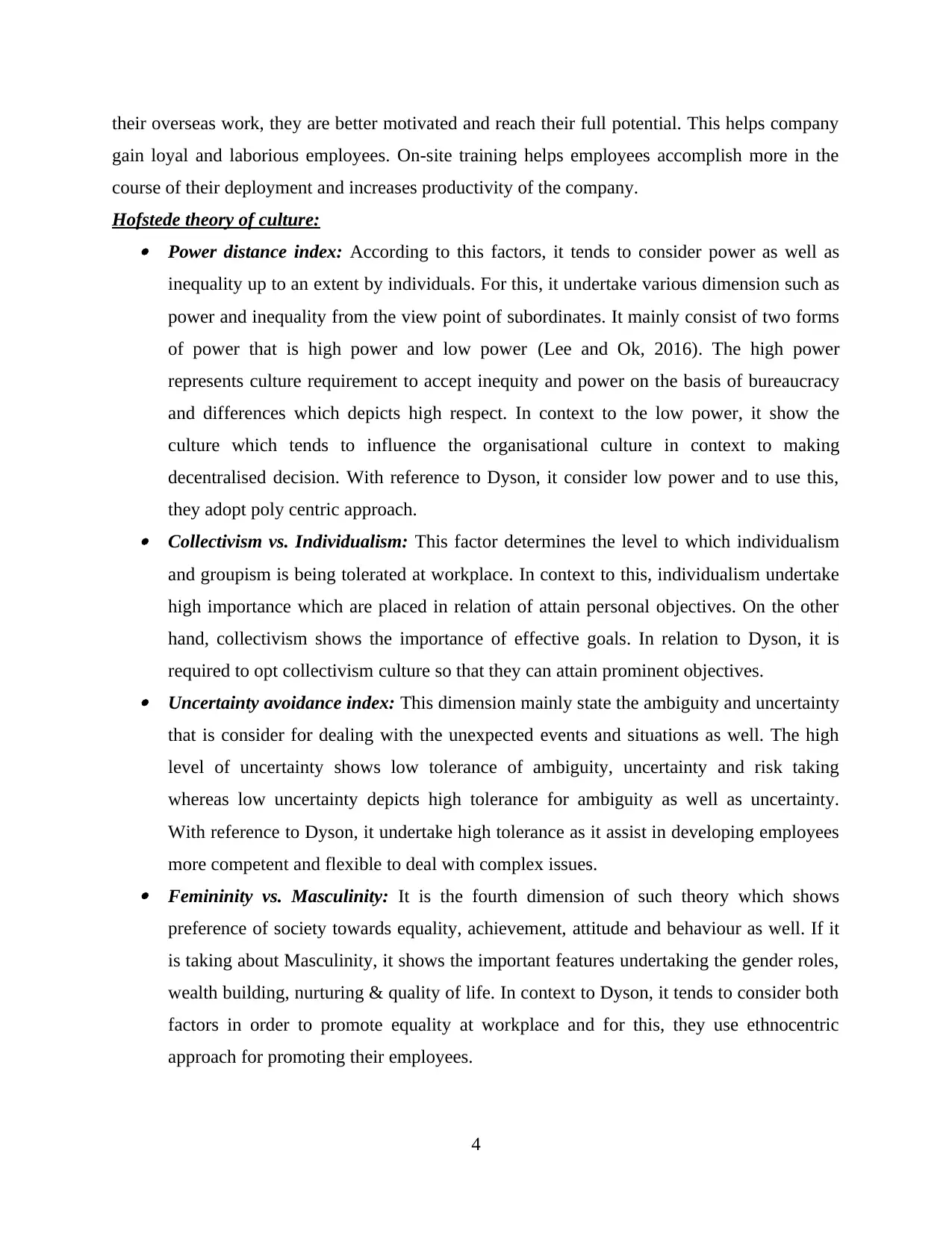
their overseas work, they are better motivated and reach their full potential. This helps company
gain loyal and laborious employees. On-site training helps employees accomplish more in the
course of their deployment and increases productivity of the company.
Hofstede theory of culture: Power distance index: According to this factors, it tends to consider power as well as
inequality up to an extent by individuals. For this, it undertake various dimension such as
power and inequality from the view point of subordinates. It mainly consist of two forms
of power that is high power and low power (Lee and Ok, 2016). The high power
represents culture requirement to accept inequity and power on the basis of bureaucracy
and differences which depicts high respect. In context to the low power, it show the
culture which tends to influence the organisational culture in context to making
decentralised decision. With reference to Dyson, it consider low power and to use this,
they adopt poly centric approach. Collectivism vs. Individualism: This factor determines the level to which individualism
and groupism is being tolerated at workplace. In context to this, individualism undertake
high importance which are placed in relation of attain personal objectives. On the other
hand, collectivism shows the importance of effective goals. In relation to Dyson, it is
required to opt collectivism culture so that they can attain prominent objectives. Uncertainty avoidance index: This dimension mainly state the ambiguity and uncertainty
that is consider for dealing with the unexpected events and situations as well. The high
level of uncertainty shows low tolerance of ambiguity, uncertainty and risk taking
whereas low uncertainty depicts high tolerance for ambiguity as well as uncertainty.
With reference to Dyson, it undertake high tolerance as it assist in developing employees
more competent and flexible to deal with complex issues. Femininity vs. Masculinity: It is the fourth dimension of such theory which shows
preference of society towards equality, achievement, attitude and behaviour as well. If it
is taking about Masculinity, it shows the important features undertaking the gender roles,
wealth building, nurturing & quality of life. In context to Dyson, it tends to consider both
factors in order to promote equality at workplace and for this, they use ethnocentric
approach for promoting their employees.
4
gain loyal and laborious employees. On-site training helps employees accomplish more in the
course of their deployment and increases productivity of the company.
Hofstede theory of culture: Power distance index: According to this factors, it tends to consider power as well as
inequality up to an extent by individuals. For this, it undertake various dimension such as
power and inequality from the view point of subordinates. It mainly consist of two forms
of power that is high power and low power (Lee and Ok, 2016). The high power
represents culture requirement to accept inequity and power on the basis of bureaucracy
and differences which depicts high respect. In context to the low power, it show the
culture which tends to influence the organisational culture in context to making
decentralised decision. With reference to Dyson, it consider low power and to use this,
they adopt poly centric approach. Collectivism vs. Individualism: This factor determines the level to which individualism
and groupism is being tolerated at workplace. In context to this, individualism undertake
high importance which are placed in relation of attain personal objectives. On the other
hand, collectivism shows the importance of effective goals. In relation to Dyson, it is
required to opt collectivism culture so that they can attain prominent objectives. Uncertainty avoidance index: This dimension mainly state the ambiguity and uncertainty
that is consider for dealing with the unexpected events and situations as well. The high
level of uncertainty shows low tolerance of ambiguity, uncertainty and risk taking
whereas low uncertainty depicts high tolerance for ambiguity as well as uncertainty.
With reference to Dyson, it undertake high tolerance as it assist in developing employees
more competent and flexible to deal with complex issues. Femininity vs. Masculinity: It is the fourth dimension of such theory which shows
preference of society towards equality, achievement, attitude and behaviour as well. If it
is taking about Masculinity, it shows the important features undertaking the gender roles,
wealth building, nurturing & quality of life. In context to Dyson, it tends to consider both
factors in order to promote equality at workplace and for this, they use ethnocentric
approach for promoting their employees.
4
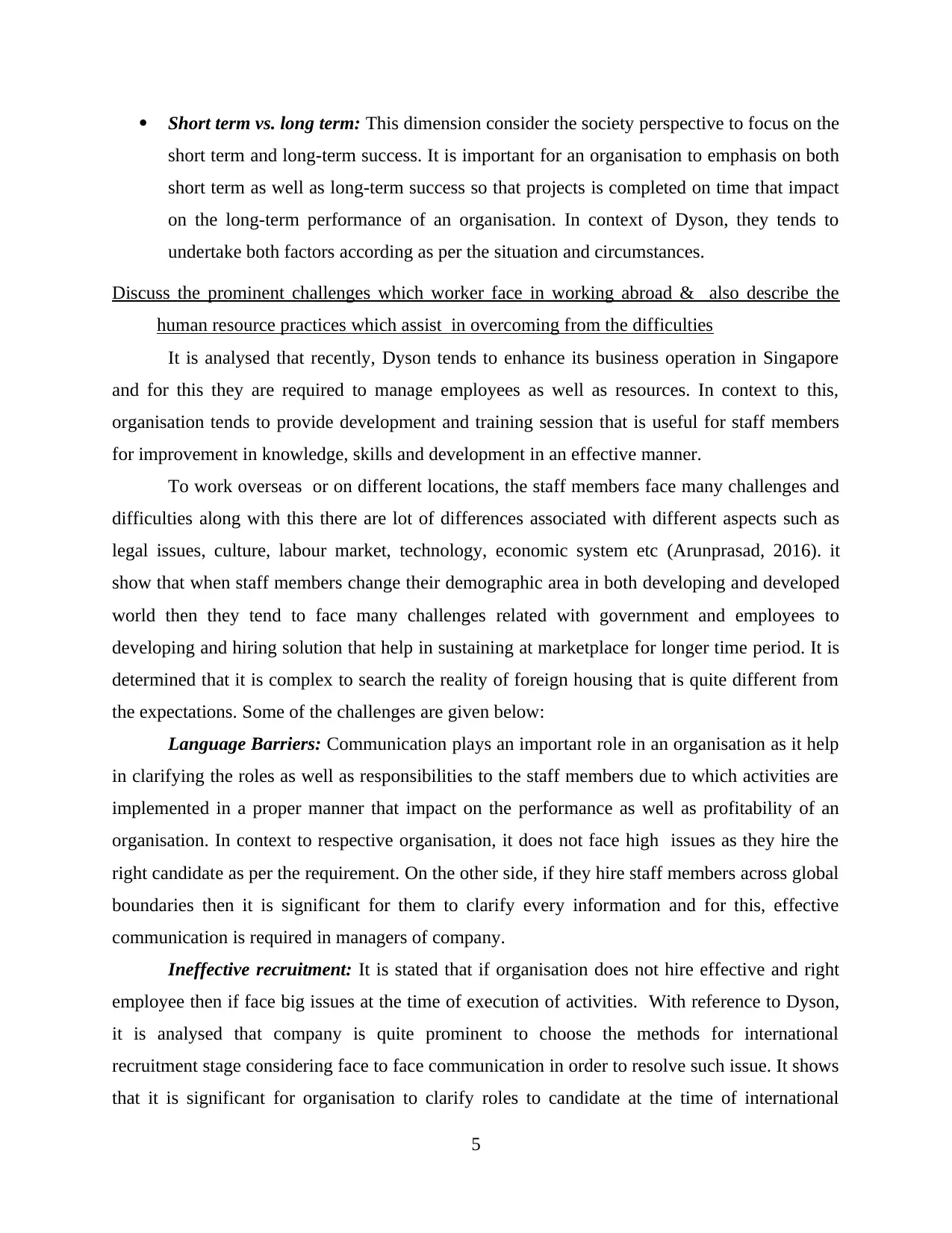
Short term vs. long term: This dimension consider the society perspective to focus on the
short term and long-term success. It is important for an organisation to emphasis on both
short term as well as long-term success so that projects is completed on time that impact
on the long-term performance of an organisation. In context of Dyson, they tends to
undertake both factors according as per the situation and circumstances.
Discuss the prominent challenges which worker face in working abroad & also describe the
human resource practices which assist in overcoming from the difficulties
It is analysed that recently, Dyson tends to enhance its business operation in Singapore
and for this they are required to manage employees as well as resources. In context to this,
organisation tends to provide development and training session that is useful for staff members
for improvement in knowledge, skills and development in an effective manner.
To work overseas or on different locations, the staff members face many challenges and
difficulties along with this there are lot of differences associated with different aspects such as
legal issues, culture, labour market, technology, economic system etc (Arunprasad, 2016). it
show that when staff members change their demographic area in both developing and developed
world then they tend to face many challenges related with government and employees to
developing and hiring solution that help in sustaining at marketplace for longer time period. It is
determined that it is complex to search the reality of foreign housing that is quite different from
the expectations. Some of the challenges are given below:
Language Barriers: Communication plays an important role in an organisation as it help
in clarifying the roles as well as responsibilities to the staff members due to which activities are
implemented in a proper manner that impact on the performance as well as profitability of an
organisation. In context to respective organisation, it does not face high issues as they hire the
right candidate as per the requirement. On the other side, if they hire staff members across global
boundaries then it is significant for them to clarify every information and for this, effective
communication is required in managers of company.
Ineffective recruitment: It is stated that if organisation does not hire effective and right
employee then if face big issues at the time of execution of activities. With reference to Dyson,
it is analysed that company is quite prominent to choose the methods for international
recruitment stage considering face to face communication in order to resolve such issue. It shows
that it is significant for organisation to clarify roles to candidate at the time of international
5
short term and long-term success. It is important for an organisation to emphasis on both
short term as well as long-term success so that projects is completed on time that impact
on the long-term performance of an organisation. In context of Dyson, they tends to
undertake both factors according as per the situation and circumstances.
Discuss the prominent challenges which worker face in working abroad & also describe the
human resource practices which assist in overcoming from the difficulties
It is analysed that recently, Dyson tends to enhance its business operation in Singapore
and for this they are required to manage employees as well as resources. In context to this,
organisation tends to provide development and training session that is useful for staff members
for improvement in knowledge, skills and development in an effective manner.
To work overseas or on different locations, the staff members face many challenges and
difficulties along with this there are lot of differences associated with different aspects such as
legal issues, culture, labour market, technology, economic system etc (Arunprasad, 2016). it
show that when staff members change their demographic area in both developing and developed
world then they tend to face many challenges related with government and employees to
developing and hiring solution that help in sustaining at marketplace for longer time period. It is
determined that it is complex to search the reality of foreign housing that is quite different from
the expectations. Some of the challenges are given below:
Language Barriers: Communication plays an important role in an organisation as it help
in clarifying the roles as well as responsibilities to the staff members due to which activities are
implemented in a proper manner that impact on the performance as well as profitability of an
organisation. In context to respective organisation, it does not face high issues as they hire the
right candidate as per the requirement. On the other side, if they hire staff members across global
boundaries then it is significant for them to clarify every information and for this, effective
communication is required in managers of company.
Ineffective recruitment: It is stated that if organisation does not hire effective and right
employee then if face big issues at the time of execution of activities. With reference to Dyson,
it is analysed that company is quite prominent to choose the methods for international
recruitment stage considering face to face communication in order to resolve such issue. It shows
that it is significant for organisation to clarify roles to candidate at the time of international
5
⊘ This is a preview!⊘
Do you want full access?
Subscribe today to unlock all pages.

Trusted by 1+ million students worldwide
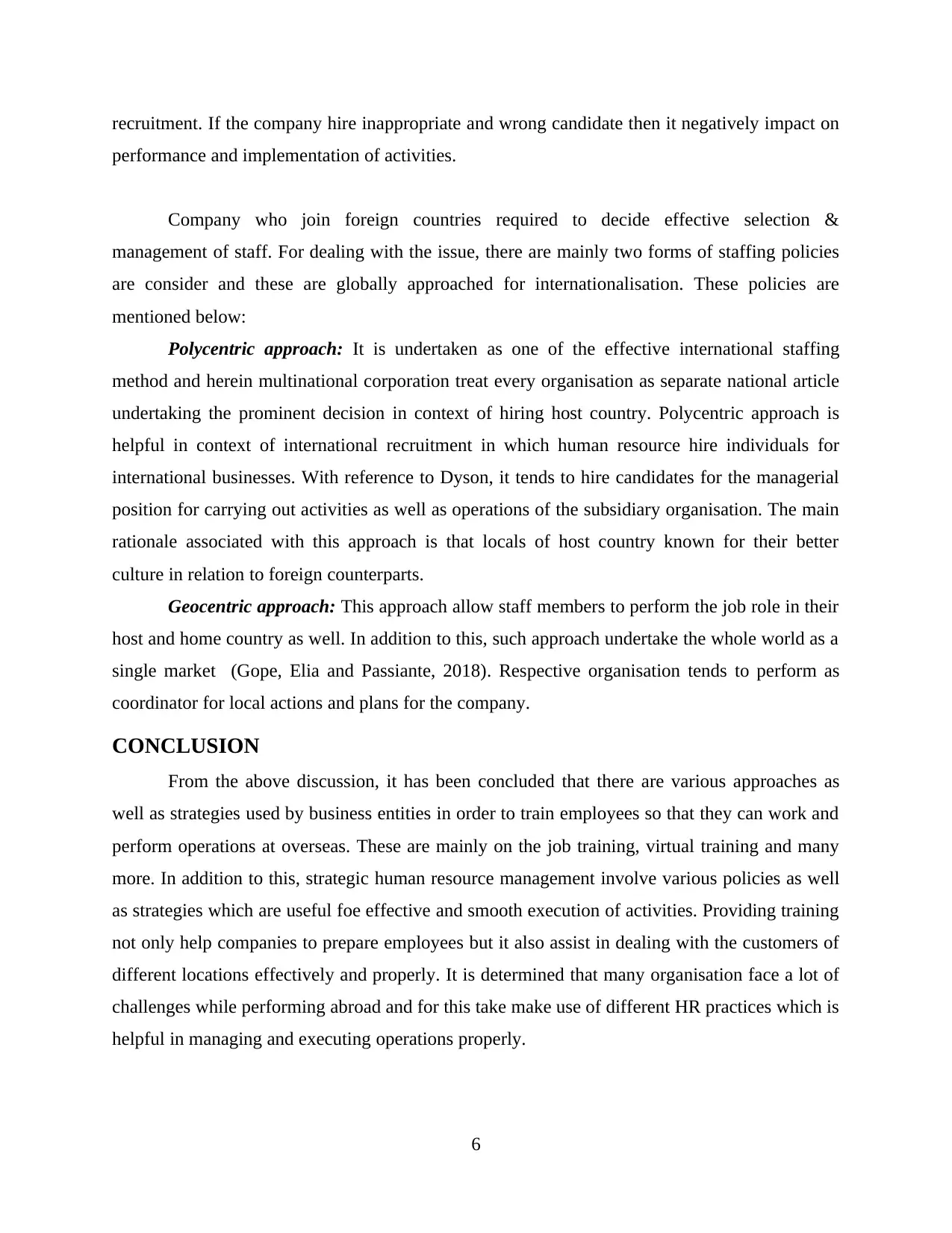
recruitment. If the company hire inappropriate and wrong candidate then it negatively impact on
performance and implementation of activities.
Company who join foreign countries required to decide effective selection &
management of staff. For dealing with the issue, there are mainly two forms of staffing policies
are consider and these are globally approached for internationalisation. These policies are
mentioned below:
Polycentric approach: It is undertaken as one of the effective international staffing
method and herein multinational corporation treat every organisation as separate national article
undertaking the prominent decision in context of hiring host country. Polycentric approach is
helpful in context of international recruitment in which human resource hire individuals for
international businesses. With reference to Dyson, it tends to hire candidates for the managerial
position for carrying out activities as well as operations of the subsidiary organisation. The main
rationale associated with this approach is that locals of host country known for their better
culture in relation to foreign counterparts.
Geocentric approach: This approach allow staff members to perform the job role in their
host and home country as well. In addition to this, such approach undertake the whole world as a
single market (Gope, Elia and Passiante, 2018). Respective organisation tends to perform as
coordinator for local actions and plans for the company.
CONCLUSION
From the above discussion, it has been concluded that there are various approaches as
well as strategies used by business entities in order to train employees so that they can work and
perform operations at overseas. These are mainly on the job training, virtual training and many
more. In addition to this, strategic human resource management involve various policies as well
as strategies which are useful foe effective and smooth execution of activities. Providing training
not only help companies to prepare employees but it also assist in dealing with the customers of
different locations effectively and properly. It is determined that many organisation face a lot of
challenges while performing abroad and for this take make use of different HR practices which is
helpful in managing and executing operations properly.
6
performance and implementation of activities.
Company who join foreign countries required to decide effective selection &
management of staff. For dealing with the issue, there are mainly two forms of staffing policies
are consider and these are globally approached for internationalisation. These policies are
mentioned below:
Polycentric approach: It is undertaken as one of the effective international staffing
method and herein multinational corporation treat every organisation as separate national article
undertaking the prominent decision in context of hiring host country. Polycentric approach is
helpful in context of international recruitment in which human resource hire individuals for
international businesses. With reference to Dyson, it tends to hire candidates for the managerial
position for carrying out activities as well as operations of the subsidiary organisation. The main
rationale associated with this approach is that locals of host country known for their better
culture in relation to foreign counterparts.
Geocentric approach: This approach allow staff members to perform the job role in their
host and home country as well. In addition to this, such approach undertake the whole world as a
single market (Gope, Elia and Passiante, 2018). Respective organisation tends to perform as
coordinator for local actions and plans for the company.
CONCLUSION
From the above discussion, it has been concluded that there are various approaches as
well as strategies used by business entities in order to train employees so that they can work and
perform operations at overseas. These are mainly on the job training, virtual training and many
more. In addition to this, strategic human resource management involve various policies as well
as strategies which are useful foe effective and smooth execution of activities. Providing training
not only help companies to prepare employees but it also assist in dealing with the customers of
different locations effectively and properly. It is determined that many organisation face a lot of
challenges while performing abroad and for this take make use of different HR practices which is
helpful in managing and executing operations properly.
6
Paraphrase This Document
Need a fresh take? Get an instant paraphrase of this document with our AI Paraphraser
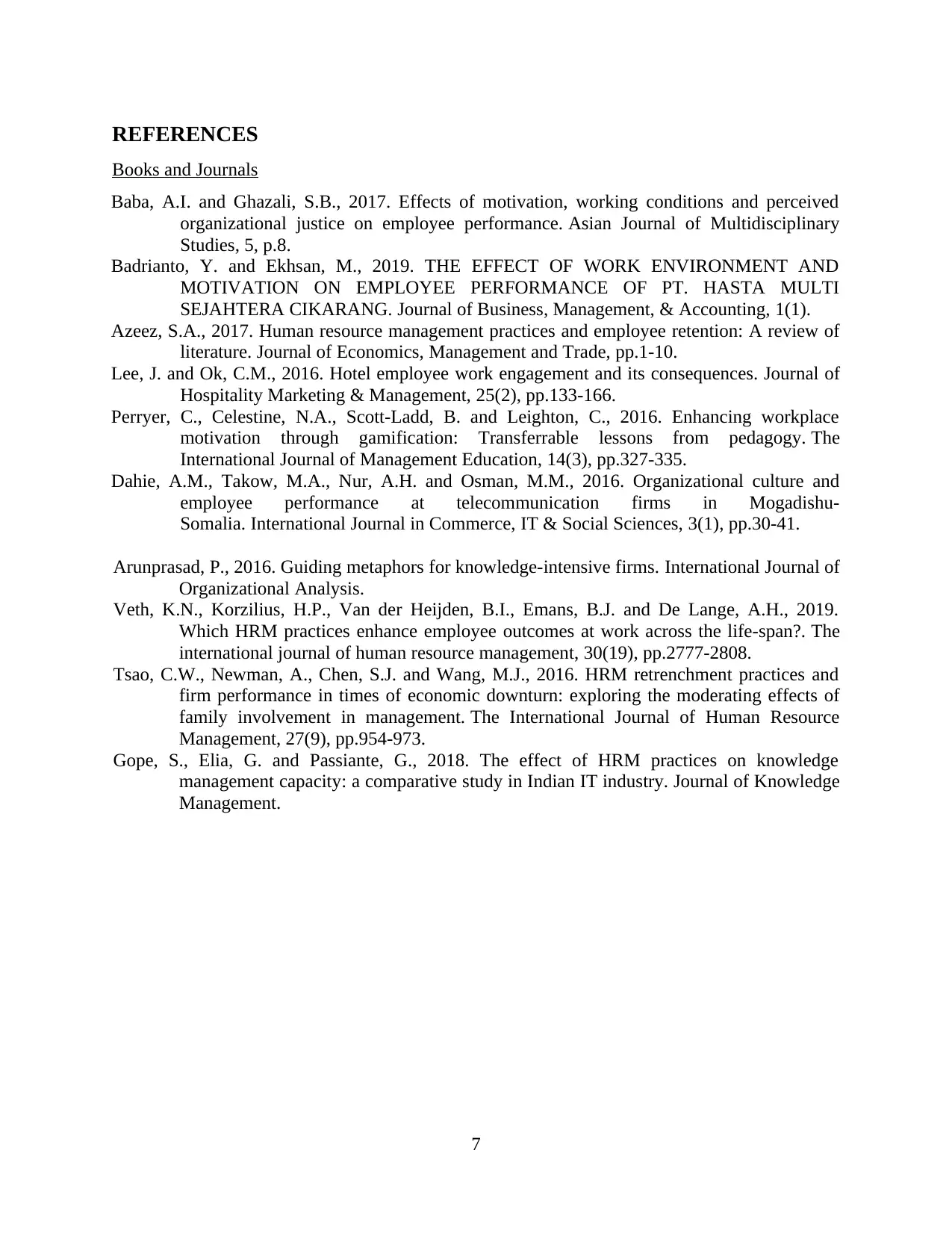
REFERENCES
Books and Journals
Baba, A.I. and Ghazali, S.B., 2017. Effects of motivation, working conditions and perceived
organizational justice on employee performance. Asian Journal of Multidisciplinary
Studies, 5, p.8.
Badrianto, Y. and Ekhsan, M., 2019. THE EFFECT OF WORK ENVIRONMENT AND
MOTIVATION ON EMPLOYEE PERFORMANCE OF PT. HASTA MULTI
SEJAHTERA CIKARANG. Journal of Business, Management, & Accounting, 1(1).
Azeez, S.A., 2017. Human resource management practices and employee retention: A review of
literature. Journal of Economics, Management and Trade, pp.1-10.
Lee, J. and Ok, C.M., 2016. Hotel employee work engagement and its consequences. Journal of
Hospitality Marketing & Management, 25(2), pp.133-166.
Perryer, C., Celestine, N.A., Scott-Ladd, B. and Leighton, C., 2016. Enhancing workplace
motivation through gamification: Transferrable lessons from pedagogy. The
International Journal of Management Education, 14(3), pp.327-335.
Dahie, A.M., Takow, M.A., Nur, A.H. and Osman, M.M., 2016. Organizational culture and
employee performance at telecommunication firms in Mogadishu-
Somalia. International Journal in Commerce, IT & Social Sciences, 3(1), pp.30-41.
Arunprasad, P., 2016. Guiding metaphors for knowledge-intensive firms. International Journal of
Organizational Analysis.
Veth, K.N., Korzilius, H.P., Van der Heijden, B.I., Emans, B.J. and De Lange, A.H., 2019.
Which HRM practices enhance employee outcomes at work across the life-span?. The
international journal of human resource management, 30(19), pp.2777-2808.
Tsao, C.W., Newman, A., Chen, S.J. and Wang, M.J., 2016. HRM retrenchment practices and
firm performance in times of economic downturn: exploring the moderating effects of
family involvement in management. The International Journal of Human Resource
Management, 27(9), pp.954-973.
Gope, S., Elia, G. and Passiante, G., 2018. The effect of HRM practices on knowledge
management capacity: a comparative study in Indian IT industry. Journal of Knowledge
Management.
7
Books and Journals
Baba, A.I. and Ghazali, S.B., 2017. Effects of motivation, working conditions and perceived
organizational justice on employee performance. Asian Journal of Multidisciplinary
Studies, 5, p.8.
Badrianto, Y. and Ekhsan, M., 2019. THE EFFECT OF WORK ENVIRONMENT AND
MOTIVATION ON EMPLOYEE PERFORMANCE OF PT. HASTA MULTI
SEJAHTERA CIKARANG. Journal of Business, Management, & Accounting, 1(1).
Azeez, S.A., 2017. Human resource management practices and employee retention: A review of
literature. Journal of Economics, Management and Trade, pp.1-10.
Lee, J. and Ok, C.M., 2016. Hotel employee work engagement and its consequences. Journal of
Hospitality Marketing & Management, 25(2), pp.133-166.
Perryer, C., Celestine, N.A., Scott-Ladd, B. and Leighton, C., 2016. Enhancing workplace
motivation through gamification: Transferrable lessons from pedagogy. The
International Journal of Management Education, 14(3), pp.327-335.
Dahie, A.M., Takow, M.A., Nur, A.H. and Osman, M.M., 2016. Organizational culture and
employee performance at telecommunication firms in Mogadishu-
Somalia. International Journal in Commerce, IT & Social Sciences, 3(1), pp.30-41.
Arunprasad, P., 2016. Guiding metaphors for knowledge-intensive firms. International Journal of
Organizational Analysis.
Veth, K.N., Korzilius, H.P., Van der Heijden, B.I., Emans, B.J. and De Lange, A.H., 2019.
Which HRM practices enhance employee outcomes at work across the life-span?. The
international journal of human resource management, 30(19), pp.2777-2808.
Tsao, C.W., Newman, A., Chen, S.J. and Wang, M.J., 2016. HRM retrenchment practices and
firm performance in times of economic downturn: exploring the moderating effects of
family involvement in management. The International Journal of Human Resource
Management, 27(9), pp.954-973.
Gope, S., Elia, G. and Passiante, G., 2018. The effect of HRM practices on knowledge
management capacity: a comparative study in Indian IT industry. Journal of Knowledge
Management.
7
1 out of 8
Related Documents
Your All-in-One AI-Powered Toolkit for Academic Success.
+13062052269
info@desklib.com
Available 24*7 on WhatsApp / Email
![[object Object]](/_next/static/media/star-bottom.7253800d.svg)
Unlock your academic potential
Copyright © 2020–2025 A2Z Services. All Rights Reserved. Developed and managed by ZUCOL.





